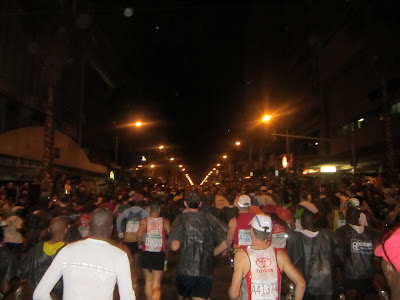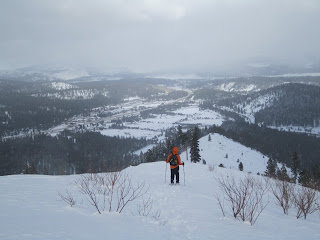On Sunday I had the pleasure of running the Comrades Marathon (actually a 54-mile ultramarathon) in South Africa with 12,000 other runners. Yes, you read that right. There's an ultramarathon with 12,000 runners. This is the worlds oldest (first run in 1921) and largest ultra, and the centerpiece of South African running culture.
All walks of South African life run this race - runners of all shapes, sizes, races, and ages. Everyone who is a runner in South Africa aspires to run Comrades. The question to runners here is not "have you run Comrades?" but rather "how many Comrades have you run?" I had been talking about this race with my South African friend Gareth for at least a couple of years so it was exciting that he and I were finally running it.
The race this year started in the coastal city of Durban and ran up to the town of Pietermaritzburg. I say ran "up", because this year the Comrades race was an "up" run. Each year the race changes directions, so next year will be a "down" run that will start in Pietermaritzburg and finish in Durban. And the "up" is not trivial. For a road race there are some serious hills. I had the chance to see the entire course the day before the race when we drove from Johannesburg, and not only did the distance seem long, but the hills looked tough. There were long climbs, and even the "flat" sections were mostly undulating.
Comrades assigns different-colored bib number colors to runners for various situations, including:
- Green = ten or more previous finishes
- Green Stripes = twenty or more previous finishes (one runner was running the race for his 45th time!)
- Blue = International runner (I wore a blue number)
- Orange = back to back runs (i.e. ran last year, and running again this year)
- Yellow = 9 finishes, going for a 10th
- and probably others I am not aware of
The Comrades race is approximately 95% South African runners, although the number of foreigners is increasing as the race starts to get more international attention (and now that the race offers some serious prize money also.) The race only opened to black runners and women runners as recently as 1975.
The race started at 5:30am in the dark. When I arrived the starting line was crowded, and a little chaotic. All runners were required to be in their assigned corral at least 15 minutes before the start. My qualifying marathon time (from the Napa marathon) put me in corral 'A' right near the start line. I positioned myself towards the back of my corral so I wouldn't get sucked into a fast pace right at the start, as I've heard many runners like to charge out of the gate as if they were running a 10k race.
While we waited for the start the loudspeakers played the theme from Chariots of Fire for inspiration, and Shosholoza, an South African folk song which is the unofficial South African national anthem. If you watched any of the 2010 World Cup you might have heard it. It's quite moving when the whole crowd is singing along.
The race began, and I ran a few of the first miles with Amy Sproston from Oregon whom I had last seen at Miwok. Amy is in Africa for a work trip - she managed to sandwich running Comrades in between a week in Nairobi and a week in Sudan. Amy got a lot of cheers "go lady!" "Good job lady!" There weren't that many other female runners up near the front where we were running. After five miles Amy stopped for a bathroom break and I didn't see her again until the finish (where I learned that she had passed me near the end of the race when I stopped to use the bathroom myself, and she finished a few minutes ahead of me)
There were an amazing number of aid stations along the race course, one every 2km, or about every mile and a half. The aid stations offered water, Energade, Pepsi (a controversial change this year from Coke), and sometimes some food - potatoes (which very salty), oranges, bananas. It was more than usually offered at a road marathon, but less food than I'm used to at a (North American) trail ultra. Interestingly the drinks were given out not in paper cups, but in plastic sachets. These are basically sealed plastic bags that hold about six ounces of liquid. To open them you bite off a corner an squeeze the water into your mouth (it took me a moment to figure this out when I was handed my first one). Sometimes if you're not careful they sort of explode all over you when you bite them open. Also it sounds a little like a gunshot when you step on a full one. Overall they're a good idea though, since you can grab a couple and easily carry them with you while you run and drink when you need to.
I ran with my camera, and am a little surprised it still works now considering the amount of water, Energade, and Gu I spilled on it during the race.
Have I mentioned the crowd support at this race? There were spectators lined up along nearly the whole route cheering enthusiastically (and politely - I got called 'sir' quite a bit). This is the sort of crowd support you only normally only see at a few big-city marathons. Comrades is a social occasion for spectators. The course passes through towns right in front of people's houses and many were making a day of it. I ran past several BBQs (or as the South Africans would say, 'braais') and was tempted by the smells. The race is broadcast on national television from start to finish, and a large portion of the country tunes in to watch at least a part of it.
Despite the uphill nature of this year's course, I found the early hills not so bad, especially after training in California. The sun was strong once it came up, but there was a breeze and it didn't seem to get hot until the later stages of the race.
At Mile 38 I was passed by Bruce Fordyce, the King of Comrades. Bruce is a legend in South African running who dominated the Comrades race with a string of victories in the 80s. He is to Comrades what Lance Armstrong is to the Tour de France. Now in his 50s, he's still fit enough to usually finish with a silver medal (although he just missed doing so today.)
Despite a strong first half, I started to slow later, and I knew by six hours into the race that my initial goal of finishing under seven and a half hours for a silver was out of reach. At that point I'd have to average 8min/mile or better for the rest of the race, including running up Polly Shortts (the last of the five big hills). Polly is not the longest hill in the race (it's just 2km long) or the steepest, but at Mile 48, with just 10k left to run, it's known to break many Comrades runners. It's the equivalent of Heartbreak Hill in the Boston Marathon. By then my legs were feeling pretty shot. I did manage to run a lot of Polly Shortts, but I had definitely slowed down from my starting pace. I found that all the pavement and the pounding had taken a toll by the end.
I happily crossed the finish line in 7:41:24 (567th place).
Link to GPS track
Link to online results
A pair of Russian twins won the women's race again, finishing first and second (they have dominated this race for the past several years) American ultrarunner Kami Semick finished third, with Canadian-based Ellie Greenwood finishing 4th. The men's winner was a Zimbabwean who had also won the previous two years.
The international runners tent at the end had food (an free beer!) and it was good to catch up and chat with some of the other foreign runners there that I knew.
And yet the day was not over yet for the vast majority of Comrades runners, most of whom were still out on the road. Gareth finished a bit later, and then we stayed with his family and his fiancee Aileen to watch the rest of the finishers continue to roll in. There is a hard cutoff of twelve hours at the finish line. Amazingly more than half of the runners in Comrades typically finish during the last hour of the race. It's quite dramatic watching runners attempt to finish under the wire. You see runners helping each other across the finish line, other runners crawling to get to the finish. One runner literally rolled across the finish line with one second to spare to make the cutoff for the 11 hour medal. We stayed till the bitter end to watch the final 12 hr cutoff.
I'll probably be back to run Comrades again though. It would be nice to try the Down Run, and of course, to get the silver medal also next time. :-)
I cannot thank Gareth's family enough for all the support they've provided to me during this trip. Special thanks to Gareth's fiancée Aileen and his Dad Neil for crewing for us during the race. (Neil himself has finished Comrades twice.)
Next: On to Botswana!



































